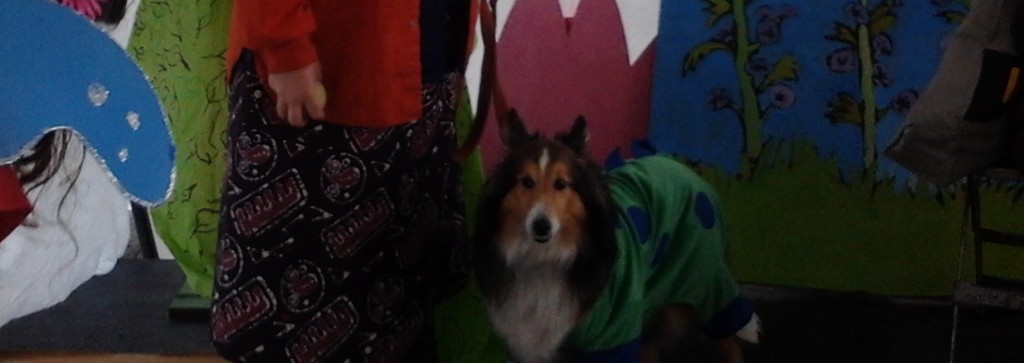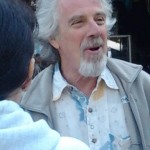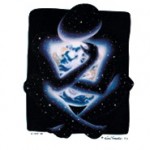The Structural Engineer and the Colander
Like thousands of other people across America for the past six months, I have lived, breathed and oozed Occupy since it’s beginnings, dedicating my waking and sleepless moments to the beautiful, hopeful, flawed movement.
Most full-timers buried themselves in working groups and showed up for every next direct action of their local Occupy. My partner, Food Not Bombs cofounder and consensus trainer C.T. Butler, and I went from one Occupy to the next, sitting in on working groups and General Assemblies and offering countless workshops, large and small.
It could have and should have been hundreds of thousands or millions who were rolling up sleeves and joining us. They came to check out their local encampments, but something happened. The movement itself, not the government, disappeared them.
From our first day or two on McKeldin Square in Baltimore’s Inner Harbor, C.T. and I were concerned about the members of the 99% who would show up, wander around, read signs, maybe hold cardboard at traffic for a while, maybe talk to people, maybe attend that night’s General Assembly, but never hook up with the event, and after one or three nights, or three weeks at most, they were gone.
Over the course of our tour of fifteen Occupy encampments in November and December of 2011, I would repeatedly talk about the people the movement was bleeding out, as if through a colander. Those people numbered so many times more than the people who stayed, the remaining “activists” often shouting their GA’s into nonfunctional institutions.
By the time, I think early January, when C.T. Butler and I came home and did a two-day Consensus: Body and Soul workshop for our own Occupy of Baltimore, General Assembly attendance had gone from two hundred and more to twenty or thirty. And some stark demographics were visible.
What I mean to say is that, as people fell into and out of the movement, draining out of that colander, two archetypes of individuals remained, attending meetings and steering the actions of Occupy: First, those shouting people who love their own ideas and dominate meetings until people go along, and second, activists who wanted to find a way to incorporate the shouters’ agendas with their own desire that everyone just get along, and some memory of a desire that all voices be heard.
We came to call the two the cowboys (gender irrelevant) and the placators/enablers.
The heat of privilege and oppression had been so high in the structure that Occupy donned that all other personality types remembered that they had laundry to do and went home. Only the cowboys and their enablers could stand it.
And the enablers aren’t happy. They call C.T. and me almost daily still with requests that we help fix Occupy.
But the enablers’ target audience, the cowboys, have lofty ideas that they should figure out their own models/structures themselves, reinventing all wheels. They don’t want C.T.’s fingerprints on anything. “We shouldn’t pay some White guy…” They say, with no understanding that what we teach comes from the Iroquois through the Quakers through the feminist movement. Read a book, please! Also, am I invisible standing next to C.T.?
One woman, upset at C.T., said she would attend our workshop if I would teach it alone! But whether people like C.T.’s packaging, personality or gender identity, he’s the one with the knowledge the movement needs, not so much me.
He’s a sort of group dynamics structural engineer. In my experience, and I’ve been in this field a long time, there are maybe five people like C.T. alive on the planet right now. And I don’t know who or where the other four are. I’m saying something important.
—WT
Please join our Hippie Chick Diaries fan page on facebook!
Subscribe to this blog's RSS feed
C.T.’s DIY Book Process
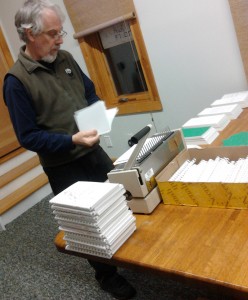 Many people wonder about the plastic binding of C.T.’s original book, On Conflict and Consensus. Originally a cost saving measure, C.T. has continued to order new printings with that spine because so many people have liked that feature, which allows them to easily lay the book open at meetings for quick reference.
Many people wonder about the plastic binding of C.T.’s original book, On Conflict and Consensus. Originally a cost saving measure, C.T. has continued to order new printings with that spine because so many people have liked that feature, which allows them to easily lay the book open at meetings for quick reference.
What they probably don’t ever consider is that C.T., Mr. Do-it-yourself, binds each copy himself, using a binder he has lovingly maintained and repaired since the 1980’s!
The printer sends C.T. boxes with the book divided into sections, into which C.T. cuts holes with the machine. Then the machine stretches the plastic spine and the ordered sections are laid inside.
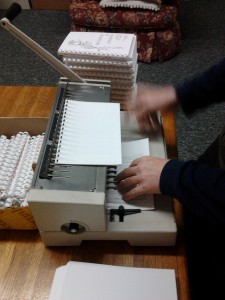 Each book takes a few minutes. And C.T. binds the copies in batches of two-hundred or so. Since its first publication in 1987, C.T. has sold well over ten-thousand copies, each of which he bound himself, spreading culture change by his own hands.
Each book takes a few minutes. And C.T. binds the copies in batches of two-hundred or so. Since its first publication in 1987, C.T. has sold well over ten-thousand copies, each of which he bound himself, spreading culture change by his own hands.
Through the years, he’s sometimes accepted help and shown others how to bind the books. But they usually didn’t bring the same mindfulness to the practice, and would often mess up the cutting or get the sections in the wrong order, ruining several copies. That made for a very costly learning curve, so C.T. prefers to carry on the practice himself.
On Conflict and Consensus and Consensus for Cities are made possible by investors who cover the cost of printing, and some of our costs of distributing the book. So when a book is ruined, we still need to pay back investors for that loss. The investors are one reason why we can’t give the books away, as we’re often asked to do.
His other books, Food Not Bombs: How to Feed the Hungry and Build Community and Consensus for Cities, are perfect bound. And when we go to place his titles on bookstore shelves, the proprietors complain about those plastic spines. They’re afraid they’ll break, rendering the stock unsellable. But we travel around, moving books from place to place, lugging them to events, and we have no problem.
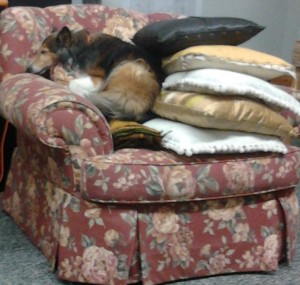 While we’re on the road, we’ve had to guess at how many books to bring. And C.T. brought the binding machine with us. These photos were taken at our friends’ house in Manorville, on Long Island, where we stayed for several weeks. Over several days, C.T. bound a couple hundred books while I organized our Consensus: Body and Soul workshop at WBAI. We had already hosted several Occupy activists from OWS, Philadelphia and Boston for a workshop in that very room.
While we’re on the road, we’ve had to guess at how many books to bring. And C.T. brought the binding machine with us. These photos were taken at our friends’ house in Manorville, on Long Island, where we stayed for several weeks. Over several days, C.T. bound a couple hundred books while I organized our Consensus: Body and Soul workshop at WBAI. We had already hosted several Occupy activists from OWS, Philadelphia and Boston for a workshop in that very room.
Tuatha, of course, would spend his time enjoying every dog’s dream chair, waiting for us to stop working and kick the ball around!
—WT
Dragons Are Not Afraid of Thunder, or A Fine Time at the St. George Day Festival
How do I end up in a pet dragon contest when I’m supposed to be coteaching a consensus workshop in Philadelphia? My life is like a road movie, just a string of random randomness.
Having postponed a workshop in Philadelphia, C.T. and I found ourselves with time to volunteer for and attend the St. George Day Festival here on Staten Island, our new home for a while. The event is organized by our friends at Every Thing Goes Book Cafe and Neighborhood Stage. The cafe is one of several businesses run by Ganas Community. We had been looking for time to plug in. So, with our schedule cleared and despite predictions of rain, plug we did.
 After our own battles with a printer dragon that wouldn’t give us the brochures we wanted, we hiked over to Ganas to help transport food. Once at the festival site, we were assigned the art project of reinforcing the bent fire and scales on a cardboard
After our own battles with a printer dragon that wouldn’t give us the brochures we wanted, we hiked over to Ganas to help transport food. Once at the festival site, we were assigned the art project of reinforcing the bent fire and scales on a cardboard  dragon for the parade. I can’t say that we improved it much, but the dragon did march and we enjoyed seeing our small work in the show.
dragon for the parade. I can’t say that we improved it much, but the dragon did march and we enjoyed seeing our small work in the show.
We helped staff the local authors table. It was interesting to see the range of books and listen to the authors read. Our own books were a little out of place there. But soon we got an invitation from the Green Bus folks, who knew of C.T.’s work with Food Not Bombs. So our materials moved. C.T. had a great time swapping stories with activists from Occupy Wall Street, Occupy Staten Island, Food Not Bombs and more.
Around that time, we found out that there was to be a pet dragon contest. As it turns out, we have a pet dragon, at least part time, specifically when it thunders.
Our sheltie Tuatha is powerful afraid of storms. And fireworks…and any other stimulation that dogs of the ages have ever tried to fear. I saw the ads for the so called “thundershirts,” and I was intrigued but skeptical, especially because the marketing included lots of fake blogs pretending to be independent testimonials.
The ads/blogs implied that the science behind the thundershirt is that it presses on certain acupuncture points on the dog, calming and making her/him feel more secure. Well, that sounds reasonable, but I couldn’t quite justify the expense without knowing it would work on my particular paranoid pup.
That’s when I remembered that Tuatha has a huge collection of Halloween costumes. I knew right away that our favorite, the dragon, would fit snugly in the way that the thundershirts in the pictures do. I tried it the very next time it stormed.
It worked. I would like to tell you a story of false advertising and how they’re just stealing your money. Well, if you have a drawer full of doggie Halloween costumes, it might be the case that you don’t need to give the thundershirt people your money. Don’t ask me how it works. C.T. and I have this whole theory about “contingent behavior” that I won’t go into here.
But the short story is that C.T. went home and got our pet dragon in time for the contest. Because the start time was delayed repeatedly, Tuatha the dragon and I walked all around the festival. He was very popular. We got to meet another contestant, Shakespeare, and his humans who were waiting in the wings. I learned more pointers than I will ever be able to blog about how to win dog contests and where to find them. It turns out the competition was professional!
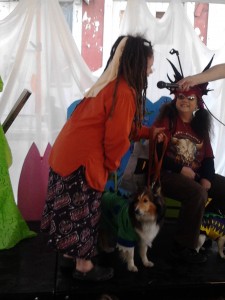 Well, this was only our second contest, the first being a parade in New Freedom, Pennsylvania. We found out about that one the day of. And now the pro’s had a leg up on us again! Shakespeare’s humans velcroed him into a much more elaborate dragon costume, one that didn’t look like he’d worn it for years of trick or treating, hours of playground wrestling and many episodes of thunder.
Well, this was only our second contest, the first being a parade in New Freedom, Pennsylvania. We found out about that one the day of. And now the pro’s had a leg up on us again! Shakespeare’s humans velcroed him into a much more elaborate dragon costume, one that didn’t look like he’d worn it for years of trick or treating, hours of playground wrestling and many episodes of thunder.
But, luck was on our side. It turned out that Shakespeare and Tuatha were the only entrants. And after applause voting (which I’m pretty sure went in Tuatha’s favor) the emcee declared a tie for first place! Fair enough. We got to win!
In other news of the day, we only sold one book but we met many interesting neighbors who would like to learn consensus. And we reconnected with old friends of Ganas Community. We took in interesting poetry and loads of fine local music. And the organizers fed the volunteers a wonderful spread, so we economized there. Very helpful in our line of work.
And we returned to our host’s home with bragging rights—We won the pet dragon contest. What? No state and nationals to follow? That suits Tuatha fine. He loves the idea of going with us when we leave home, but he’s not always thrilled at the places we go. Costumed crowds are no fetish of his.
—WT
Discovering the Secret World of Strollers
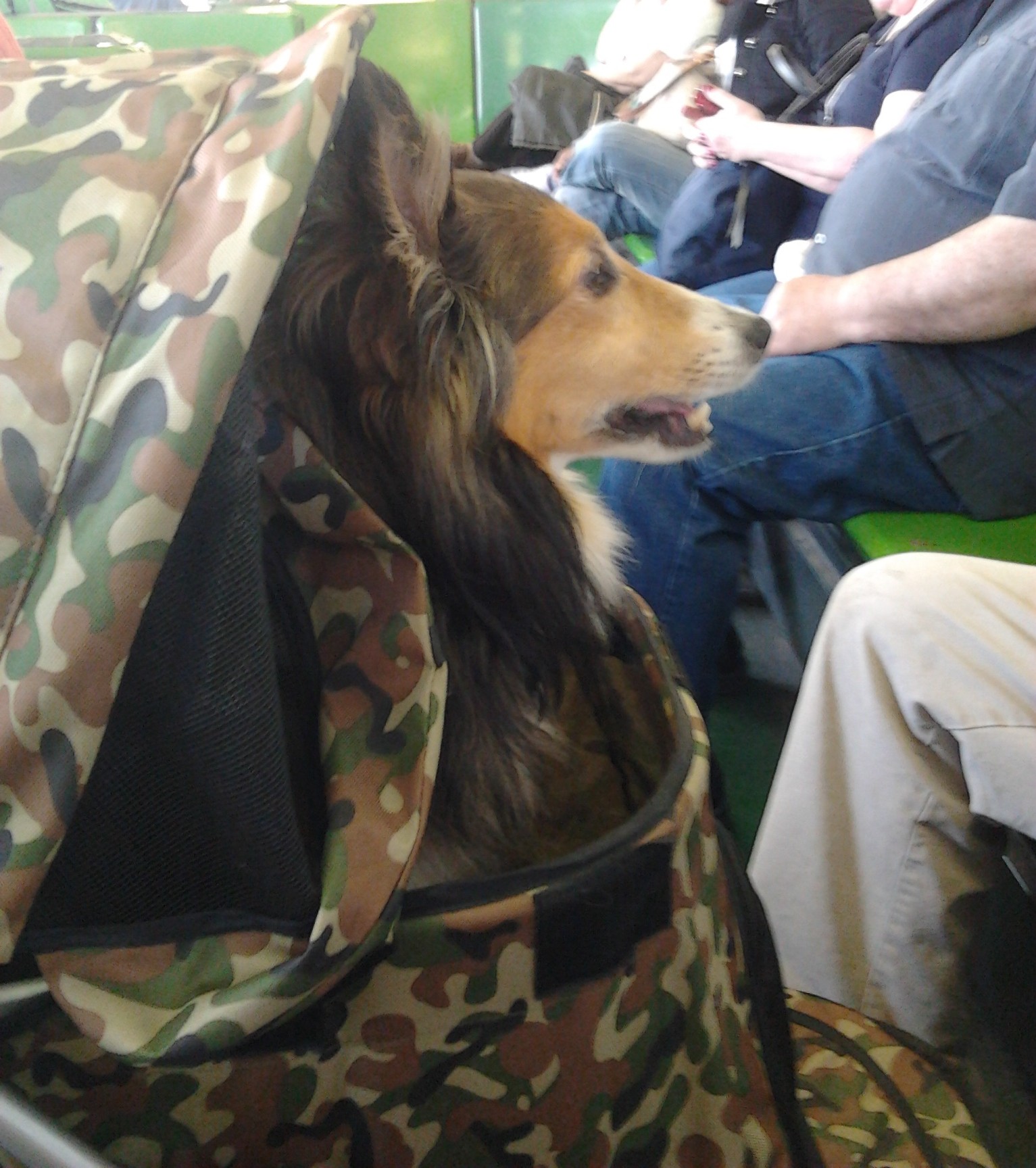 I never would have come up with this one on my own. But as I have found my way through the rivers of people in New York City, I’ve discovered that owners of dogs, particularly small dogs, travel the sidewalks and subways with their pets in purses, totes and, get ready for it, doggie strollers.
I never would have come up with this one on my own. But as I have found my way through the rivers of people in New York City, I’ve discovered that owners of dogs, particularly small dogs, travel the sidewalks and subways with their pets in purses, totes and, get ready for it, doggie strollers.
I don’t necessarily see it every time I get on the subway, but from time to time, there’s Fifi, parked under Mama’s arm, contained in a tote with a mesh window. I would never have envisioned this, even though I am a dog mama and a new immigrant to the really, really, really Big Apple.
I am a reluctant resident at best. Work keeps me here for a few months. My partner C.T. and I have a host who’s opened his Staten Island home to us and our dog, Tuatha. But we want to be able to take Tuatha to Occupy and other outdoor events, and to visit friends, etc.
So as we moved to Staten Island, we took the plunge and ordered a doggie stroller. The experience of shopping online and ordering was simple enough. Not all strollers are created equal; You get what you pay for, etc. I needed a fairly large one for my twenty-nine pound Sheltie, but bigger costs more. After much hunting we found one that fits his frame and has larger, sturdy wheels, a requirement of mine after years of pushing human strollers. An added bonus: Camouflage fabric! I never cease to be amused at camouflage in unexpected or ironic places. My favorite used to be my camouflage cloth menstrual pads, but the fru-fru dog stroller beats that hands down, if only because few people notice what cloth menstrual pad I’m wearing….Sigh.
The stroller was delivered to a friend’s house in Brooklyn. So before we took it home, we used it to carry C.T.’s consensus books to an Occupy event in Central Park. This was when I learned about stroller culture, and the secret tribe of people who know stroller ways.
First, people made way for me, held doors for me and made adoring looks at me, even though the stroller was empty. In the subway, when an escalator was broken someone grabbed the front of the stroller and carefully helped me carry it down the stairs while carefully keeping it level, so as not to wake the sleeping…books and flowchart handouts.
Sitting on the subway or in a restaurant, I would notice a human toddler in a stroller staring at me with a mommy vibe, as if I must know mommy things because I am sitting next to a stroller.
Just as other people with dreadlocks make eye contact with me and give a knowing nod, now so would stroller people. All this while I was pushing books.
 Once at home, just presenting the new conveyance to Tuatha was worth the investment. I wish I had videotaped it. Tuatha was like a kid who’s letter to Santa got answered. He seemed to know what it was for and that it was his, before we even put him inside. He circled it, chirping and nipping at it, then rushing between me and C.T. to nuzzle and kiss. He was sooo thrilled! It was as if he saw this thing with wheels that was his size, and he just knew he’d been given his first car.
Once at home, just presenting the new conveyance to Tuatha was worth the investment. I wish I had videotaped it. Tuatha was like a kid who’s letter to Santa got answered. He seemed to know what it was for and that it was his, before we even put him inside. He circled it, chirping and nipping at it, then rushing between me and C.T. to nuzzle and kiss. He was sooo thrilled! It was as if he saw this thing with wheels that was his size, and he just knew he’d been given his first car.
When we put him inside and velcroed the mesh cover around him, he sat beaming. And he was unphased by the first movement, and the bumps in the driveway. He just looked at us through the mesh window in the top, and checked our location through his side view, and he was good to go, go, go.
Knowing that we wanted to eventually take him on public transportation, we decided to first take him to a park, creating positive associations. Even though he didn’t need to ride in the stroller to the nearest park, he did so, and loved every moment, not even missing all the poles and bushes he would have wanted to mark.
At the park, he got out, played fetch, relaxed with us, and then got a stroller ride home. Perfect! Next, a dry run on the ferry.
The Staten Island Ferry is free, and just a few blocks from our house. So when we need to go to work downtown we are able to walk to the dock, take the ferry and then we’re in Manhattan. Our only transportation cost is the subway. Before, when we were staying far out on Long Island, a trip into the city cost the two of us nearly $100, between the Long Island Railroad, subways and food.
So a ferry ride, our first experiment with Tuatha and public transportation, would only cost us our time. We walked him by leash to the ferry terminal, put him in the stroller and onto the ferry. The only surprise was that Tuatha became unhappy when his stroller was not being pushed. When we stood still in line and when we were in our seats on the ferry, he complained. He wanted us to make his little car go!
On the sidewalk, and in line for the ferry, some people would look inside the stroller to discover that our child was a dog. It’s funny. There are people who will look in strollers and those who just don’t. Tuatha got many ooohs and ahhhs everywhere he went. I’m sure there were people who thought it was terrible, but no one confronted us.
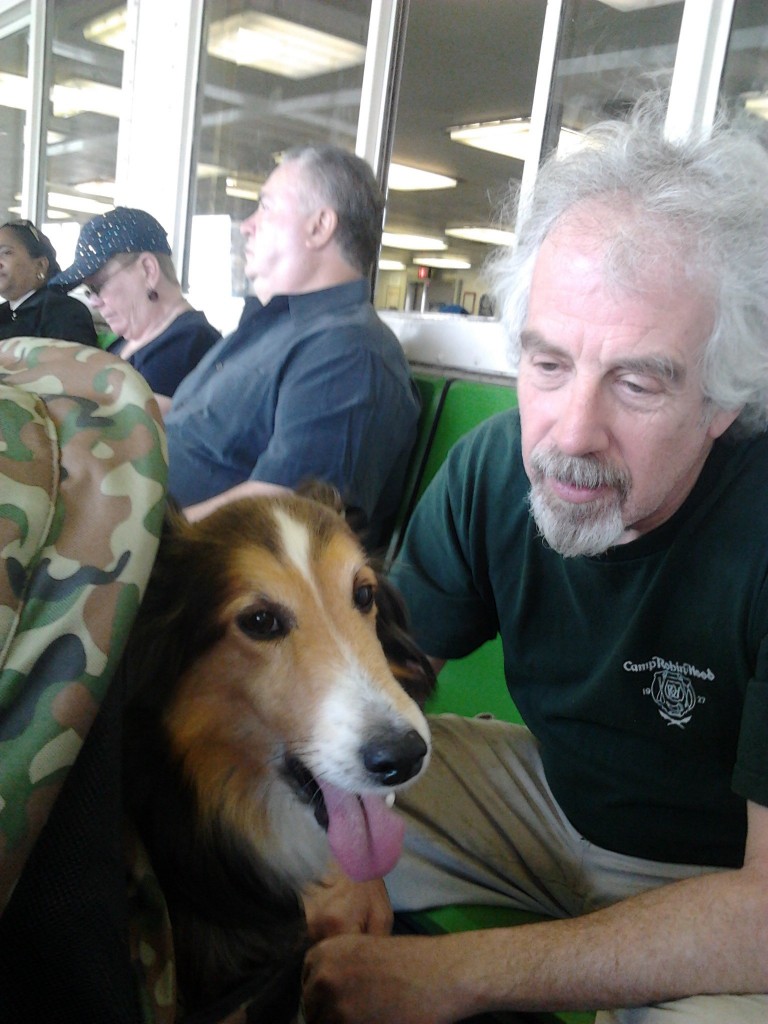 Having ridden the ferry about a dozen times before Tuatha got on, I was worried that the loud foghorn would scare him. Same for the scrape that the ferry makes against the wood pier when it docks. So we made sure to be on the far side of the ferry from those stimuli. Otherwise, the ferry’s motions and engine sounds were gentle enough that Tuatha seemed unphased. Just bored that his car had stopped!
Having ridden the ferry about a dozen times before Tuatha got on, I was worried that the loud foghorn would scare him. Same for the scrape that the ferry makes against the wood pier when it docks. So we made sure to be on the far side of the ferry from those stimuli. Otherwise, the ferry’s motions and engine sounds were gentle enough that Tuatha seemed unphased. Just bored that his car had stopped!
On the Manhattan side, we wheeled him off for a nice relaxing picnic in Battery Park next to the ferry terminal. Since it’s New York, there was no finding a bench for just ourselves, so Tuatha worked on bribing the people on either side of us into sharing their bread. He has a bread addiction. And this was a park where his drug of choice could be had. He didn’t score, but he tried.
Next we’ll have to venture onto the subway with him, during some off peak time. The subway is much louder but, given how well he’s taken to stroller travel so far, he may avoid panic by feeling secure in his enclosure. I won’t push the issue if he doesn’t like it, of course.
But I already consider the stroller experiment successful, not because it provides me with flexibility, but because Tuatha gets such a kick out of it! I strolled him to the fruit stand the other day and he could roll through the open air market with me, complaining when I stopped to examine produce. I put my selections on top of the stroller and put my purchases in the storage bin underneath for the stroll home.
One challenge is that our host’s house is at the top of a long, steep hill that empties into the bay. So every trip everywhere starts with a long walk down and ends with a long walk up. But if Tuatha and I make more trips to the produce stand for fewer things, I get more exercise in the long run, and let no one dispute that I need exercise.
Already I have date set for tomorrow. Tuatha and I will stroll with a friend from Ganas Community. C.T. and I are lucky to be just a few blocks away from an Intentional Community where we know many people. Some of them are, I believe, stroller people…
